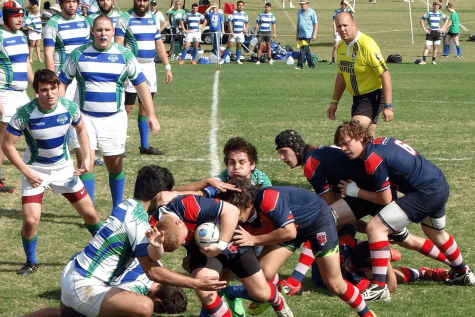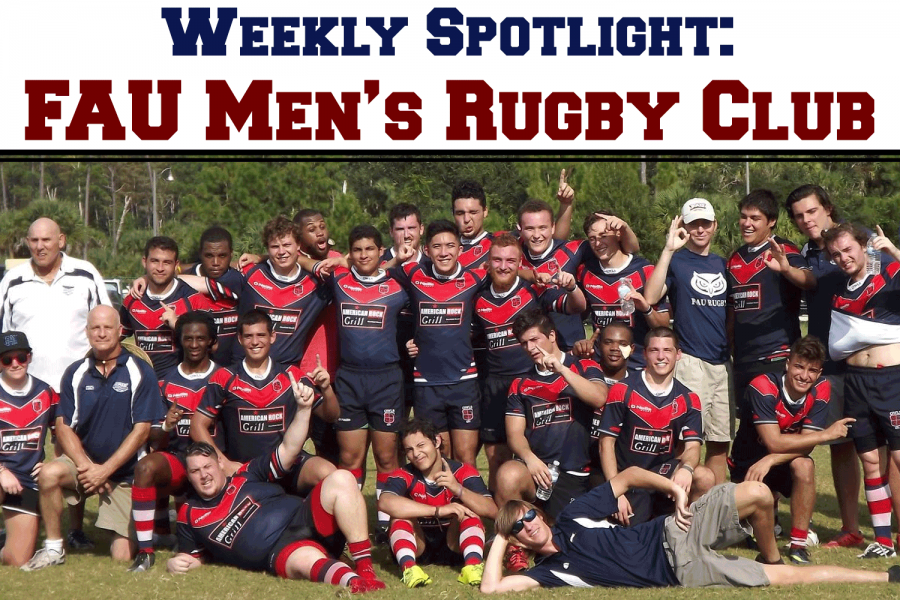Weekly Spotlight: FAU Men’s Rugby Club
FAU Men’s Rugby Club has been on campus for the past 25 years and and has 34 active members
The FAU Men’s Rugby Club meets for practice every Tuesday and Thursday from 7:30 p.m. to 9:30 p.m. Photo courtesy of FAU Men’s Rugby Club.
March 10, 2016
Welcome to the Weekly Spotlight, where you can learn about on-campus organizations in one easy place.
This week we spoke with Anthony Bonanno, president of FAU Men’s Rugby Club. The club has 34 active members and competes with other Florida universities through tournaments.
This interview has been edited for clarity.
UP: What can you tell me about FAU Men’s Rugby Club?
AD: We’ve been an organization on campus for 25 years, this is our 25th anniversary. We set up games with other schools around Florida, sometimes national. We play schools like FIU, FSU, UM … UNF, FGCU, just all schools all around Florida. Basically it’s a combination of football and soccer. It’s a great sport.
UP: What are your competitions like?
AD: We have normal games that we schedule either at their school or here, and then we have tournaments that we can go to, and there are usually two each semester. And then for tournaments we have two or three games, and each game is about 80 minutes. Usually they are all-day or weekend tournaments.
Usually, it’s multiple different leagues, like the men’s league, college teams, there are some high school teams, so anywhere between 15 to 20 teams, all from different leagues. We’re in the collegiate men’s league, so currently we are Division II — we were bumped down from Division I last year, but we’re working our way back there to get up to Division I. Division I is the bigger schools like FSU, FIU, UCF, schools like that, and Division II are smaller schools like UNF, FCGU.
UP: What’s the team atmosphere like?
AD: We try and stay competitive, when we’re not on the field we’re pretty laid back. We have a good time, hang out, go out, just normal things. Currently we are at 34 [members]. We normally have about 20, 25 show up on a regular basis. We’re trying to get about 35 to 40 kids total, just so we have enough for being able to have full scrimmages at practice. Normally on the field you have 15 players on each side, and then you subsitute people — I think you have six substitutes in a game, and you just play the full 80 minutes, it’s two 40-minute halves.
UP: Are there a lot of injuries involved in rugby?
AD: Any contact sport, there are injuries, but compared to football, there are not nearly as many injuries. Football’s a lot more rough than rugby. It’s hard to think because without the pads, people think it’s worse. But honestly, the way you learn to do certain things, you have less injury, fewer concussions than football. Injuries happen in all contact sports. Actually, a couple of weeks ago one of our players dislocated his knee. Nothing tore or anything, but he’s back now, he’s jogging, he’s running around with us, back to normal.
UP: Are there any safety measures that you take for the sport?
AD: Most of the injuries happen from people who don’t know what they’re doing. We just kind of train them on how to play the game. If you know how to play the game, then you won’t injure yourself.
UP: What’s the hardest part of playing?
AD: Getting up off the ground. With all the contact that happens and the running around, it’s tiring enough running from one side of the field to the other and running up and down, but once you make a tackle, getting up from that tackle is the hardest part, honestly.

UP: What advice would you give to beginners?
AD: Watch a lot of rugby. Go online, go on YouTube, and just try and find as much as you can because when you watch the game you understand the flow of the game, so it makes it easier, a lot easier.
UP: What’s something the average student wouldn’t know about rugby?
AD: Not everyone’s huge, most of the people are small. Most are under 5’1. By football the average height is like 6’1, 6’2 and like 200 pounds, where rugby it’s really similar but not everyone’s huge, so don’t be afraid if you are small. Each position, there’s a general weight and height. How in football there are linemen that are like 300-pound guys, and then there are running backs [that] are like 180. Where rugby, you kind of have the same differential of weight, but it’s between forwards and backs. Forwards are the big guys, and backs are the smaller, faster guys. In football there’s an offensive and defensive side, in rugby the 15 players play both sides — they play both offense and defense the way you would in soccer or any other sport.
UP: When are your weekly meetings?
AD: We meet three times a week, Tuesdays and Thursdays is practices from 7:30 to 9:30 [p.m.], and then Monday we have film nights from 9:30 to 11:30 [p.m.]
UP: What are the film nights?
AD: Where we watch the previous game that we had played in that week, and then we critique what we need to work on, things we did well, things we didn’t do well. We’re actually building a scaffolding, about ten feet high, that we will be able to stand there and film the game. We have a person, Charlie Velasquez, who films the rugby games. He runs Florida Rugby. He normally films our games and we’re trying to find more people to film, actually.
UP: What would you tell someone interested in joining?
We’re always looking for people to come out and play. It doesn’t matter, you can start from not knowing anything about the sport to having played for 10 years. So, we’ll teach you everything you need to know … Don’t be afraid to try. We’d rather people mess up because they were trying too hard than not do something.
UP: Is there anything else you would like to add?
AD: We actually have a small scholarship. It isn’t anything big — it’s not going to pay your tuition or anything like that, but it’s a little something that the players get. That’s through our alumni foundation, from all the people that have played since we’ve been around for 25 years, we have a lot of alumni. They put together something every year for us, every fall.
Brittany Ferrendi is the features editor of the University Press. If you would like to contact her regarding this or other stories, she can be reached at bferrend@fau.edu or on Twitter.






